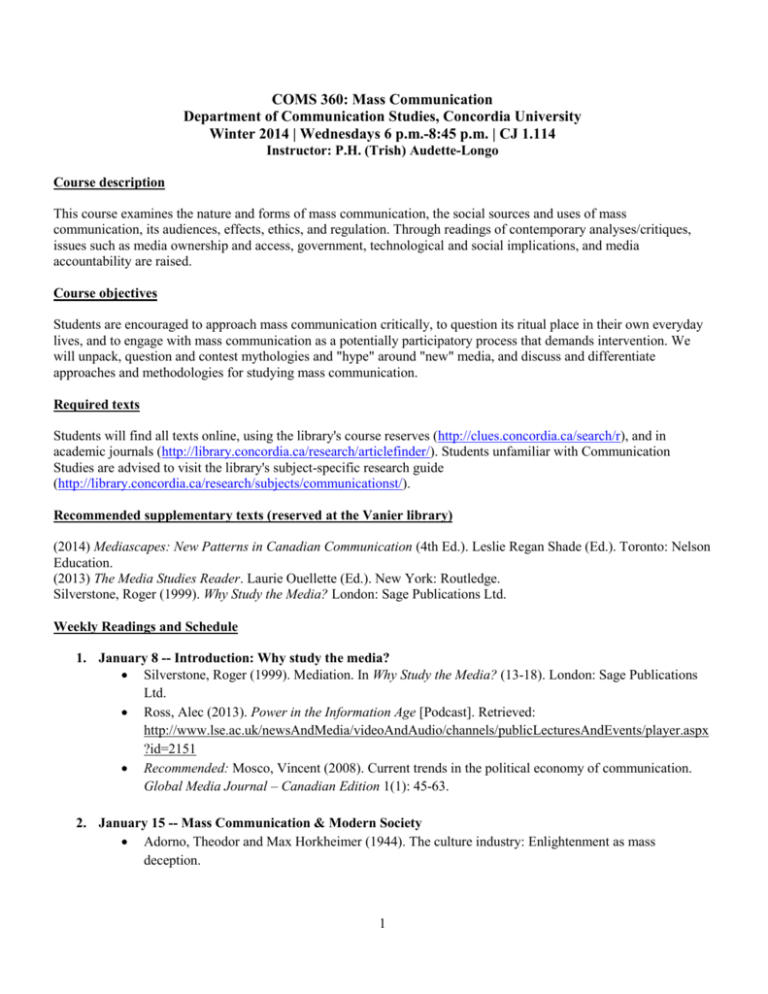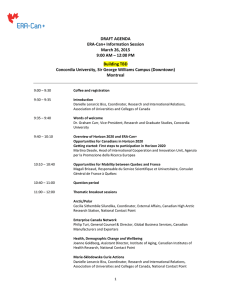COMS 360: Mass Communication
advertisement

COMS 360: Mass Communication Department of Communication Studies, Concordia University Winter 2014 | Wednesdays 6 p.m.-8:45 p.m. | CJ 1.114 Instructor: P.H. (Trish) Audette-Longo Course description This course examines the nature and forms of mass communication, the social sources and uses of mass communication, its audiences, effects, ethics, and regulation. Through readings of contemporary analyses/critiques, issues such as media ownership and access, government, technological and social implications, and media accountability are raised. Course objectives Students are encouraged to approach mass communication critically, to question its ritual place in their own everyday lives, and to engage with mass communication as a potentially participatory process that demands intervention. We will unpack, question and contest mythologies and "hype" around "new" media, and discuss and differentiate approaches and methodologies for studying mass communication. Required texts Students will find all texts online, using the library's course reserves (http://clues.concordia.ca/search/r), and in academic journals (http://library.concordia.ca/research/articlefinder/). Students unfamiliar with Communication Studies are advised to visit the library's subject-specific research guide (http://library.concordia.ca/research/subjects/communicationst/). Recommended supplementary texts (reserved at the Vanier library) (2014) Mediascapes: New Patterns in Canadian Communication (4th Ed.). Leslie Regan Shade (Ed.). Toronto: Nelson Education. (2013) The Media Studies Reader. Laurie Ouellette (Ed.). New York: Routledge. Silverstone, Roger (1999). Why Study the Media? London: Sage Publications Ltd. Weekly Readings and Schedule 1. January 8 -- Introduction: Why study the media? Silverstone, Roger (1999). Mediation. In Why Study the Media? (13-18). London: Sage Publications Ltd. Ross, Alec (2013). Power in the Information Age [Podcast]. Retrieved: http://www.lse.ac.uk/newsAndMedia/videoAndAudio/channels/publicLecturesAndEvents/player.aspx ?id=2151 Recommended: Mosco, Vincent (2008). Current trends in the political economy of communication. Global Media Journal – Canadian Edition 1(1): 45-63. 2. January 15 -- Mass Communication & Modern Society Adorno, Theodor and Max Horkheimer (1944). The culture industry: Enlightenment as mass deception. 1 Recommended: Downing, John and Alan O'Connor (1995). Culture and communication. In J. Downing, A. Mohammadi, and A. Sreberny-Mohammadi (Eds.), Questioning the Media: A Critical Introduction (3-22). Thousand Oaks, CA: Sage Publications Inc. 3. January 22 -- Texts and Interpretations I Hall, Stuart (1999 [1973]). Encoding, decoding. In S. During (Ed.), The Cultural Studies Reader, 2nd Ed. (507-517). London: Routledge. Entman, Robert M. (1993). Framing: Toward clarification of a fractured paradigm. Journal of Communication 43(4): 51-58. 4. January 29 -- Texts and Interpretations II Media Action Media (2011). Representations of Diversity in Canadian Television Programming: Case Studies. http://www.media-action-media.com/wp-content/uploads/2012/05/MAM_DiversityResearch-Report_FINAL.pdf Required sections of this report include: the executive summary (4-8); theoretical and discursive framework (23-33); case studies overview (34-36); Ainsley Jenicek's case study of Little Mosque on the Prairie (52-69); Appendix 1: Diversity-related policy initiatives (141157). The remainder is recommended for your consideration of both the media journal assignment and the final project. Recommended: Roth, Lorna, Leen d'Haenens and Thierry Le Brun (2011). No longer 'the other:' A reflection on diversity in Canadian fiction television. International Communication Gazette 73: 380399. 5. February 5 -- Media as Everyday Practice Manovich, Len (2009). The practice of everyday (media) life. Critical Inquiry 35(2): 319-331. Shade, Leslie Regan (2007). "It just sucks you in:" Young women's use of Facebook. Retrieved: http://www.media-action-media.com/wp-content/uploads/2011/12/shade-mediaction-nov07.pdf Recommended: Nick Couldry (2004). Theorising media as practice. Social Semiotics, 14(2): 115-132. 6. February 12 -- Media ownership, institutions and policy Shtern, Jeremy and Sylvia Blake (2014). Power and politics at the CRTC: The recent past and uncertain future of Canada's communications regulator. In L. Shade (Ed.), Mediascapes: New Patterns in Canadian Communication, 4th Ed. (84-106). Toronto: Nelson Education. Middleton, Catherine (2011). From Canada 2.0 to a digital nation: The challenges of creating a digital society in Canada. In M. Moll and L. Shade (Ed.), The Internet Tree: The State of Telecom Policy in Canada 3.0 (3-13). Ottawa: Canadian Centre for Policy Alternatives. Retrieved: http://www.policyalternatives.ca/sites/default/files/uploads/publications/National%20Office/2011/06/I nternet_Tree_0.pdf 7. February 19 -- Reading Week 8. February 26 -- Media as Professional Practice I In-class screening: Achbar, Mark and Peter Wintonick (Directors). Manufacturing Consent: Noam Chomsky and the Media, 1992 documentary. 2 9. March 5 -- Media as Professional Practice II In-class screening: Rossi, Andrew (Director). Page One: Inside the New York Times, 2011 documentary. Beckett, Charlie (2013). Saving Journalism: How far we have come in five years and where we must go now [Blog post]. Retrieved: http://blogs.lse.ac.uk/polis/2013/03/03/saving-journalism-how-far-wehave-come-in-five-years-and-where-we-must-go-now/ Couldry, Nick (2009). Does 'the media' have a future? European Journal of Communication 24(4): 437-449. 10. March 12 -- Media as Ritual Cottle, Simon (2006). Mediatized rituals: Beyond manufacturing consent. Media, Culture and Society 28(3): 411-432. Baltruschat, Doris (2009). Reality TV formats: The case of Canadian Idol. Canadian Journal of Communication 34(1): 41-59. 11. March 19 -- Mediated Moral Panics LaVraie, Bruce (2010). Mods, rockers, folk devils, deviants. Vice (United Kingdom). Retrieved: http://www.vice.com/en_uk/read/mods-rockers-folk-devils-deviants McRobbie, Angela and Sarah L. Thornton (1995). Rethinking 'moral panic' for multi-mediated social worlds. The British Journal of Sociology 46(4): 559-574. 12. March 26 -- Alternative Media and Hacking the System Uzelman, Scott (2012). Autonomous media: Re-conceptualizing alternative media practices. In K. Kozolanka, P. Mazepa, D. Skinner (Eds.), Alternative Media in Canada (65-84). Vancouver and Toronto: UBC Press. Recommended: Klein, Naomi (2000). Culture jamming: Ads under attack. In No Logo: Taking Aim at the Brand Bullies (279-309). 13. April 2 -- The Promise of Media as Everyday Life Silverstone, Roger (2007). The Mediapolis and Everyday Life. In Media and Morality: On the Rise of the Mediapolis (106-135). Cambridge, U.K.: Polity Press. 14. April 9 -- Conclusion Assignments and evaluation Media journal: Mass communication tune-out reflection: Take-home midterm exam: Final project: Participation: 10% 20% 30% 30% 10% 3 Assignment 1 due 29 January: Media journal (10%) Over the course of four consecutive days, you are asked to document your own media use, questioning how the time you spend watching TV, perusing or contributing to Twitter, or listening to the radio fits with the rest of your life. If, "media reports based on the latest offers of media technology regularly mislead us as to the pace of change because they underplay the inertia of habit" (Couldry 2012: 19), this is an opportunity to move beyond anecdotal descriptions of how we might interact with media, to query and assess your own media habits. Further, you are asked to consider the content of the media you encounter on a daily basis, and question gaps in representation. It is strongly recommended you consider the methodologies and case studies outlined in the 2011 report Representations of Diversity in Canadian Television Programming and Entman's (1993) article on media framing prior to approaching the media journal assignment. (Source: Couldry, N. (2012). Media, Society, World: Social Theory and Digital Media Practice. Cambridge, U.K.: Polity Press.) Assignment 2 due 12 February: Mass communication tune-out reflection paper (20%) Building upon the questions raised by your media journal, class readings, and lectures, you are asked to "tune out" of the media, or not use mass communication, for four consecutive days. The objective of this exercise is to further analyze and critique your own media use and ask questions about what is missing during the tune-out period. A successful two-page reflection paper will speak to the challenges you faced in avoiding mass communication, consider relevant class readings, and weigh whether "tuning out" is itself a media intervention. Cited works should be listed on a third page when you hand in the assignment. Your grade will reflect the clarity with which you express your critical thinking on the "tune out," not the extent to which you successfully "tuned out." This assignment should not be used to avoid completing work for any classes. One-to-one communication such as telephone calls or e-mails are exempt, but working through your own definition of what constitutes mass communication is part of this assignment. Mid-term Exam due 26 February: (30%) The mid-term exam will be distributed in class on February 12, and it will be due in class on February 26 after the reading week break. Further details will be outlined on February 12, but the key objective of the exam will be to critically analyze and synthesize course material in a clear and concise manner. Assignment 3 due 9 April: Final project (30%) You are asked to develop a media research project that would contest assumptions about, or challenge representations in, mass communication. This final project will include developing and justifying a clear research question, outlining why such research is necessary by drawing upon other research material, and outlining the best method for answering your research question. For example, you might draw out a content analysis coding frame, a plan for critical discursive analysis, a series of questions for individual or group interviews, a workshop agenda, or develop an alternative means of answering your research question. An appendix should be included to illustrate the codebook, interview questions, workshop agenda, media diary, etc. The objective of this assignment is to move beyond descriptions of mass communication research to actively intervene, or to begin to answer lingering questions you have about media policies or practices. 4 If you are writing in English, the paper portion of this project should be 5-7 pages, excluding a bibliography of at least seven sources and a detailed appendix showing your research model. If you are writing in French, the paper portion should be 7-9 pages, excluding bibliography and appendix. You have the option to work with a partner. Both team-members will hand in one paper and receive the same grade. If you are working as a pair, you are required to include a second appendix (one page) reflecting upon how working as a team contributed to thinking through the research question and methodology. 5






